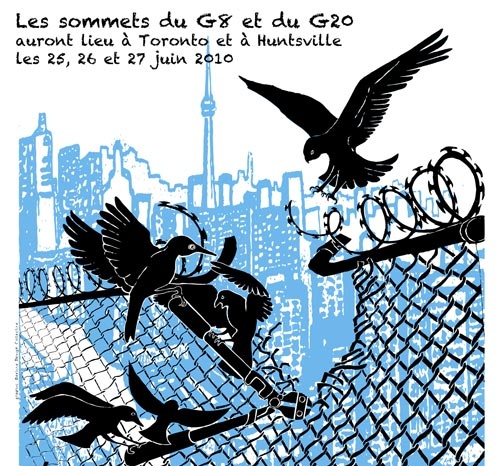 |
 |
 |
 |
 |
 |
|
 |
 |
 |
 |
 |
 |
 |
Régions du Québec |  |
 |
 |
|
 |
 |
|
 |
 |
|
 |
 |
 |
 |
 |
 |
Rubriques (sujets) |  |
 |
 |
|
 |
 |
|
 |
|
 |
 |
 |
Visiting an MST Occupation
Last month, a Canadian traveling through Brazil visited an MST occupation. Here are some reflections on the day.
On April 25 I traveled deep into the interior of the Brazilian state of Sao Paulo, to a town called Jacarei, to visit a three week old MST occupation. We were picked up at the nearest MST office by a local member, who drove us to the camp. While driving past a police check point the driver quickly took off his MST embroidered baseball hat. It was already well past noon, the sun was beating relentlessly and none of us were interested in a delay.
The driver’s fears were not unfounded. Since its initial land occupations in 1984, the Movimento dos Trabalhadores Sem Terra (MST) or the Landless Workers’ Movement, now the world’s largest agrarian reform movement, has seen its share of violence. Just a couple of days before, on April 17, the MST as well as peasants’ movements worldwide, commemorated International Day of Peasant Struggle, in memory of the 19 MST peasants murdered five years ago in Eldorado de Carajas, in Northern Brazil. As of yet, none of the perpetrators of the massacre have been brought to justice. While the most infamous incident of violent repression, the Eldorado massacre was not unique. In 1995, for example, police entered an MST camp in the area of Corumbiara in the middle of the night and killed 11 peasants, including a seven year old girl who was shot in the back.
With over one million activists, the MST is the largest social movement in the hemisphere and as a result of land occupations, the MST has won more than 250,000 families titles to over 15 million acres of previously unused land. Ethical reactions to the movement’s tactics vary. But supporters might sight the following two factors. First, for many, the MST is logical response to a clear and unceasing crises of land distribution in a country where less than 3% of the population controls two-thirds of Brazil’s arable land. Another figure estimates that one percent of rural properties represent 47% of all agricultural land, and 62% of these large ranches or Latifundas are unproductive. Meanwhile, 4.8 million Brazilian farmers have no access to land. In its 500 years of history, the state of Brazil has seen scarce measures taken to alleviate such disparities.
Secondly, the post- dictatorship Constitution itself allows the government to appropriate idle, unproductive land and redistribute it for agrarian reform. But the rural elite’s influence on government policy has predictably halted much necessary reform. For many then, the MST’s occupations which aim to help negotiate expropriation are a reaction to the unwillingness of government to comply with its own legislation and help alleviate the suffering of millions.
We pulled into the site, called Ecologio Chico Mendes, to find a red MST flag raised in front of an old wooden gate, locked with a padlock and guarded by several unarmed men. There we met our host and guide for the day Eliseu Osorio. Eliseu is a 40 year old farmer and inhabitant of a nearby established camp called Santa Rita, occupied in 1998 and awaiting formal legalization from the government. When asked what he was doing here Eliseu explained that he left his home to come to Ecologio and help them set up. This kind of solidarity appeared very natural among activists here.
Our guide described how the people first came here. On April 10, approximately 100 families arrived and occupied the 1,920 hectares of land, owned by a descendent of political patriarchs. Eliseu insisted that the land, which is in fact very fertile, is scarcely used. The people who have come here now he continued, are here not only to live but to grow food and cultivate the land.
Local leftist parties including the PT (Workers’ Parties) helped provide some basic logistical support and some food, clothing and potable water. The occupiers have since built for themselves modest temporary shelters of bamboo structures, fastened with elastic bands and covered with sheets of black plastic. Later I would read how these black plastic tents were actually the signature structure of the MST. Their floors were the dirt ground and their beds old, foam mattresses.
As we walked along the camp’s pebble road, Eliseu explained how last year, on April 17, a group of families tried to occupy this same land, as one of 250 planned MST actions throughout Brazil on the anniversary of the Eldorado massacre. After 25 days however, the people were expelled from the land. Police tactics were reportedly repressive and 13 peasants were arrested including two minors and a local priest. When asked why they had returned to the same place, one inhabitant simply offered that “their struggle is not an easy one, but that success is always possible.”
While walking we passed many of the occupiers working on their tents, clearing land, and cutting firewood. We visited the common pantry, which housed the camp’s food and clothing provisions. There we met a pregnant 22 year old mother of 3 sweeping the floor. I asked her if she thought people here minded outside visitors like us peering so closely into their lives. Laughing, she answered that people here needed to see that others were watching their struggle and that in a way this showed that they were not completely alone. She told us to come back often, explaining that visits help give the people here strength. Glad I asked.
On our way we passed another house of bamboo and elastic being built. This, explained Eliseu, is to be the school for the children. The remark hinted at an expectation that the settlement would in fact be allowed to remain and develop on this occupied land, though any evidence of this was not forthcoming.
And yet Eliseu was probably encouraged by the example of the hundreds of successful occupations which have resulted in legalized settlements. The month before for instance, I visited an MST settlement in the southern province of Rio Grande do Sol called Campao Capella. Occupied in 1993 by 53 families, Capella Camp is now a legalized MST settlement, which has flourished in terms of production and culture. Now inhabited by approximately 100 families, the camp harvests rice, various fruits, chicken and milk in what appeared to be a well developed agricultural infrastructure. The MST peasants here lived in stone houses and shared communal recreational and cultural spaces as well as a school.
But back in Ecologio Chico Mendes, the peasants are from realizing this dream. Though the people here seemed to have close to nothing they always found something to offer us throughout the day. In the afternoon I was treated to a most welcome cup of coffee and as the sun set and the camp was thrown into darkness, we were invited to the communal kitchen for a bowl of seasoned rice. We sat on the kitchen’s stoop and ate, while behind us the cook prepared another batch of rice by candlelight.
As night came on and the mosquitos descended, we prepared to leave. While waiting at the gate for our ride, we watched cars arrive carrying MST members returning from a meeting with lawyers and the local authorities. The result of this much anticipated meeting was a guarantee of a 7 day extension period in which the MST might negotiate a settlement for the occupiers. While for many the news was hopeful, others contended that there was still a big possibility they would be expelled from the land. When asked where these people would go, Eliseu explained that they have nowhere to go and would simply have to find a stretch of land near the highway and pitch tents. His optimism still in tact however, Eliseu added “we’ll be back”.
While on the political stage, MST leaders are denouncing seed patents and condemning global trade agreements which destroy local production, the people here seem to be tackling more immediate challenges such as food, shelter and if and where their children might go to school.
Before leaving we were approached by an 8-year old boy who proceeded to display his singing talents for the crowd with a serenade. He sang, “This is our county, this is our flag...and we want to take care of this land, this country Brazil, with thirst and with passion.”
A few weeks later I contacted the regional MST office to follow up on Ecologio Chico Mendes. I was told that on May 5 the 100 families which had occupied the land for nearly a month had been expelled. The MST had failed to negotiate a settlement. When asked where the people had gone to, I was told that they were currently living in tents on the side of the highway 9km away from the site.
As the Brazilian winter sets in, the landless peasants I met at Ecologio Chico Mendes will now wait, on the side of a highway, for antoher opportunity to occupy and cultivate land which they may one day call their own.
 |
 |
 |
 |
Dossier G20 |  |
 |
 |
|
 |
 |
|
 |
Nous vous offrons plusieurs reportages indépendants et témoignages...

Liste des activités lors de ce « contre-sommet » à Toronto Vous pouvez aussi visiter ces médias alternatifs anglophones... Centre des médias Alternatifs Toronto 2010.mediacoop.net Media Co-op Toronto http://toronto.mediacoop.ca Toronto Community Mobilization www.attacktheroots.net (en Anglais) |
 |
 |
 |
 |
 |
 |
 |
CMAQ: Vie associative |  |
 |
 |
|
 |
 |
|
 |
 Collectif à Québec: n'existe plus. Impliquez-vous ! |
 |
 |
 |
 |
 |
 |
 |
 |
|
 |
 |
 |
Ceci est un média alternatif de publication ouverte. Le collectif CMAQ, qui gère la validation des contributions sur le Indymedia-Québec, n'endosse aucunement les propos et ne juge pas de la véracité des informations. Ce sont les commentaires des Internautes, comme vous, qui servent à évaluer la qualité de l'information. Nous avons néanmoins une
Politique éditoriale
, qui essentiellement demande que les contributions portent sur une question d'émancipation et ne proviennent pas de médias commerciaux.
This is an alternative media using open publishing. The CMAQ collective, who validates the posts submitted on the Indymedia-Quebec, does not endorse in any way the opinions and statements and does not judge if the information is correct or true. The quality of the information is evaluated by the comments from Internet surfers, like yourself. We nonetheless have an
Editorial Policy
, which essentially requires that posts be related to questions of emancipation and does not come from a commercial media.


